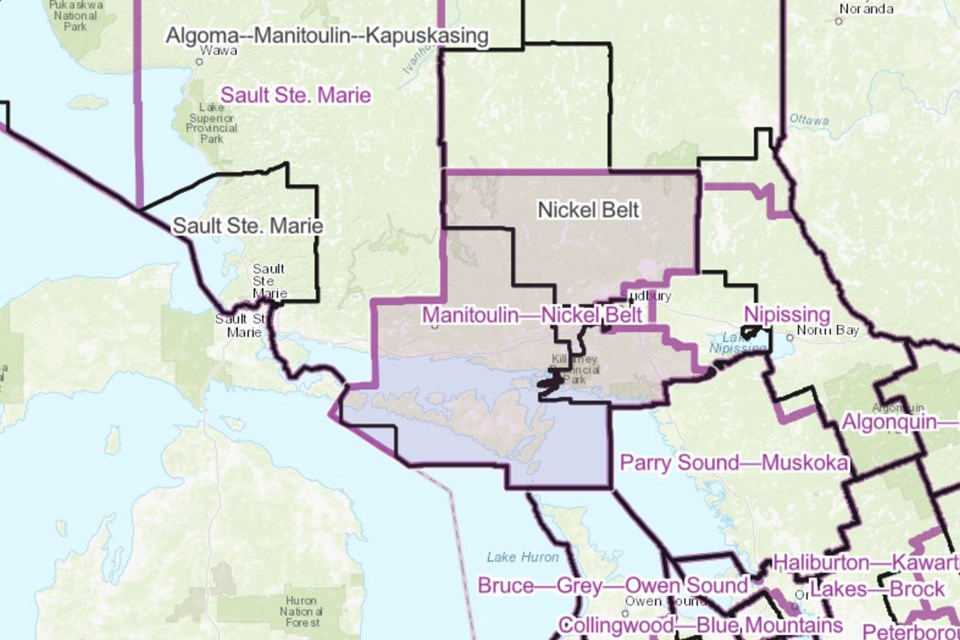Municipal governments from throughout Northern Ontario are banding together in opposition to a proposed reduction in the number of federal electoral districts in the region.
This week, the Federation of Northern Ontario Municipalities issued a media release in which they expressed opposition to reducing the region’s number of ridings from 10 to nine.
“FONOM would ask that the commission retain the current 10 electoral districts as they are today, plus the planned Indigenous representation (in the creation of the northernmost riding of Kiiwetinoong—Mushkegowuk),” according to the media release, issued on behalf of the organization which advocates on behalf of 110 cities, towns and municipalities.
A motion by Ward 7 Coun. Mike Jakubo and Ward 9 Coun. Deb McIntosh being presented at the Sept. 13 city council meeting is expected to contribute to the collective voice against the commission’s proposed changes.
In their motion’s preamble, they note the elimination of the Algoma-Manitoulin-Kapuskasing District and the creation of the larger Manitoulin-Nickel Belt riding would contribute to “weakening the North’s voice in Parliament.”
The Electoral Boundaries Readjustment Act requires independent commissions be struck in each province and territory every 10 years to examine population changes and reconfigure riding boundaries accordingly.
The commission strives for a population of 116,590 for each of the 122 ridings in Ontario. Ridings in the North have an average population below 100,000, reflecting the region’s lower population density.
The proposed change would increase the size of both the Sudbury and Nickel Belt ridings.
Nickel Belt would become Manitoulin-Nickel Belt, and would technically no longer be a belt around the Sudbury riding. The riding would stretch from the U.S. border east to encompass Manitoulin Island and the French River region as far east as Noelville, as well as Espanola and Elliott Lake. The northern border of the riding would extend from west of Biscotasi Lake Provincial Park to Obabika River Provincial Provincial Park.
The Sudbury riding would keep its name, but grow to encompass Coniston and Wahnapitae nearly as far east as Stinson, and would grow to the north to include Capreol, Garson, Falconbridge and the Greater Sudbury Airport.
Current federal listings cite the Sudbury electoral district population at 91,532 and the Nickel Belt population at 93,772.
If the proposed changes were implemented, the new Sudbury electoral district’s population would be 113,618 and Manitoulin-Nickel Belt’s population would be 99,268.
The commission released a map of its proposed riding redistribution on Aug. 19, which can be viewed by clicking here.
In Jakubo and McIntosh’s motion, the limited consultation process to make these changes – “only one in-person consultation in Northern Ontario to be held in Timmins (The Senator Hotel at 6:30 p.m. on Oct. 11)” – is also criticized.
The motion they hope to pass on Sept. 13 urges the Federal Electoral Boundaries Commission for Ontario to withdraw their plan, and for their resolution to be forwarded to the commission prior to the Sept. 25 deadline, as well as to Sudbury Liberal MP Viviane Lapointe and Nickel Belt Liberal MP Marc Serré, and the Federation of Northern Ontario Municipalities.
Northern Ontario’s MPs expressed their support for this advocacy last month, at which time Serré noted the boundary change would lengthen MPs travel time between communities and weaken the representation MPs can provide their constituents.
The reduction in the number of ridings might also affect the amount of government funding available for Northern Ontario, he added.
In this week’s media release by the Federation of Northern Ontario Municipalities, it’s noted MPs already have a difficult job fairly representing their constituents due to their electoral districts’ large size, which the change will only exacerbate.
“The MPs do an admirable job and represent Canada well, but we believe the new alignments will make their efforts even more difficult.”
The lone in-person consultation session in Timmins is inadequate, the federation added, noting it also comes in the midst of a civic election cycle and in the midst of hunting season.
“The timing of the Commission's consultation highlights a further lack of understanding for our part of Ontario,” they note, recommending they increase and extend consultation until January.
The deadline for written submissions is Sept. 25, public hearings begin on Sept. 26 and run until Oct. 29. A final report will be published before the end of December.
MP objections will be gathered from November 2022 to May 2023, and the commission will review objections until June of next year. The representation order is set for September 2023.
All the information required to make a submission can be found by clicking here.
Tyler Clarke covers city hall and political affairs for Sudbury.com.
